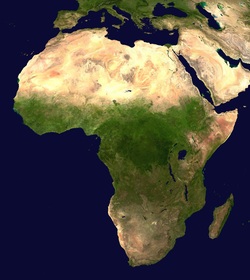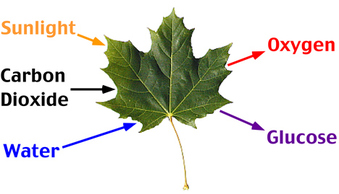General Information
The hot desert is one of the world's largest biomes, which is a major biotic community characterized by the dominant forms of plant life and the prevailing climate. Deserts cover about 1/5th of the Earth's surface and have rainfall less than 50 cm/year. Most of the hot deserts are located in low altitudes and carry more organisms than people believe. The Sahara Desert is the biggest hot desert in the world, and covers a region of almost 4 million square miles in northern Africa.
Geographic Location
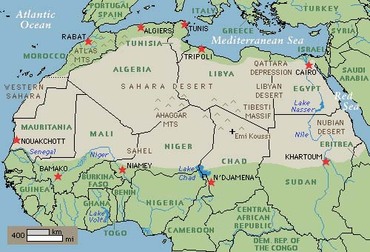
Wikipedia Geographic locations. http://wikipedia.com/saharadesert01
Measuring 9,100,000 square kilometers, the Sahara Desert spans twelve countries in northern Africa and stretches from the Red Sea to the outskirts of the Atlantic Ocean. Its terrain ranges from mountains and rocky areas to gravel plains, salt flats, and huge areas of dunes. This desert, the biggest one in the world, crosses many different national boundaries and have somewhat distinct characteristics in each nation because of the slight changes of climate and precipitation.
Climate and Seasonal Changes

Made by Angela Song on Microsoft Excel on Nov. 26. 2010
The climate of the Sahara Desert is generally that of a very dry and subtropical area, caused by high pressure cells over the Tropic of Cancer. Winters are considered cool for desert conditions, which an average of 55° F (13° C), while summers are blistering hot, with the highest temperature ever recorded at 136° F (58° C). Rainfall ranges from 1 cm per year to as much as 65 cm per year, as shown on the climatograph to the right. Precipitation amount peaks from October to February, and there is almost no rain at all during July and August. However, on rare occassions, August brings flash floods, which sends water to parts of the desert that usually does not receive precipitation. Noticeably in the climatograph, the Sahara has many limiting factors especially for plant life that is not adapted to its aridity. The lack of precipitation can be detrimental to many nonnative plants and animals.
Organisms
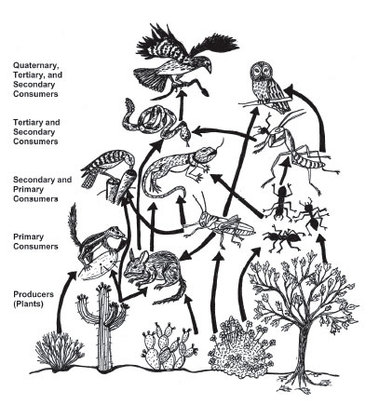
'Hot Deserts of the World.'Desert. Missouri Botanical Garden, 27Nov. 2010.
Web. 29 Nov 2010. http://www.mbgnet.net/sets/desert/hot.htm
Web. 29 Nov 2010. http://www.mbgnet.net/sets/desert/hot.htm
The Sahara Desert contains a wide diversity of organisms, contrary to popular belief. Producers, which exist in the primary trophic level, include the African Welwitchsia (which survives due to its deep roots), the African Peyote Cactus (which survives due to its thick stems), the Date Palm (one of the most important exports of Sahara plants), and Eragrostis (a rapidly-spreading grass consumed by most consumers). These organisms take in sunlight and, through photosynthesis, produce nutrients that are consumed by primary consumers. Primary consumers, who are herbivores and exist at the second trophic level, include birds like the African Silverbill, Black-throated Fire Finch, and Desert Eagle; as well as camels, rats, ostrich, and goats. Secondary and tertiary consumers, which include carnivores and exist at the third and fourth trophic levels, may consume only secondary and primary consumers, or even consume producers, in which case they are omnivores. These secondary and tertiary consumers consist of the cobra, rattlesnakes, viper breeds, the monitor lizard, and the praying mantis. Quaternary consumers also are prominent, such as the hawk. The Saharan Cheetah is one of the many endangered species that dwell in the Sahara that takes its role at the top of the food chain. At the fifth trophic level are decomposers, including beetles, termites, earthworms, and bacteria that break down dead organisms and return nutrients to the soil. The structure of the food web in the Sahara is pretty distinct and gives each organism a unique niche corresponding to its spot in the trophic level.
Soil Composition
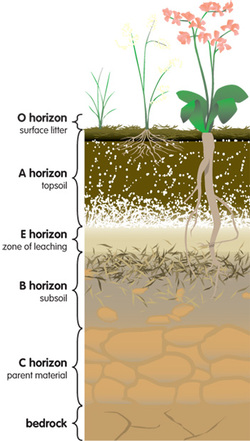
'Hot Deserts of the World.'Desert. Missouri Botanical
Garden, 27Nov. 2010. Web. 29 Nov 2010.
http://www.mbgnet.net/sets/desert/hot.htm
Garden, 27Nov. 2010. Web. 29 Nov 2010.
http://www.mbgnet.net/sets/desert/hot.htm
The soil is course-textured, shallow, and rocky or gravely with good drainage in the Sahara Desert, meaning that there is no subsurface water. It has an abundance of nutrients because it only needs water to become productive. This is very beneficial to the Sahara's plants because the soil provides the water it needs to survive without having precipitation for many weeks and sometimes even months. The soil is composed of very little or no organic matter. There is less chemical weathering in the Sahara Desert than in any other biome, making the soil coarse. Piles of finer dust and sand particles do form in certain areas near bodies of water and locations with more water substance, but when the particles are blown away, the other places are left with heavier pieces of the harder and more coarse soil. Sand covers about 20% of surface of the Sahara Desert.
According to the diagram on the left, the O horizon would consist of the fine dust and sand particles that are most thought of as prevalent in a hot and dry desert like the Sahara. However, the A and E horizons consist of the more important and omnipresent type of soil found in the desert, which is the more course and gravely soil which lets water drain through quickly so that the plant can reach hydration before it drys up. In the desert, the B horizon is mostly hard clay where not many roots of plants can reach. The landscape and sculpting of the sand dunes and mountainous regions are hardened by this B horizon subsoil, and other soils can "rest" upon the base layer.
According to the diagram on the left, the O horizon would consist of the fine dust and sand particles that are most thought of as prevalent in a hot and dry desert like the Sahara. However, the A and E horizons consist of the more important and omnipresent type of soil found in the desert, which is the more course and gravely soil which lets water drain through quickly so that the plant can reach hydration before it drys up. In the desert, the B horizon is mostly hard clay where not many roots of plants can reach. The landscape and sculpting of the sand dunes and mountainous regions are hardened by this B horizon subsoil, and other soils can "rest" upon the base layer.
Average Gross Primary Productivity
Primary productivty is the measurement of the amount of organic compounds made from carbon dioxide through the process of photosynthesis. The amount of primary productivity depends on the autotrophs of the specific biome, which are plants that can make their own food and cover the base of the food chain. Specifically, the gross primary productivity is the rate at which an ecosystem's producers capture and store a given amount of chemical energy as biomass in a given length of time. Some of this chemical energy is used for respiration of the plants, and when that loss is taken into consideration, the total becomes the net primary productivity.
Finding the exact GPP of a biome is very difficult, as the course of respiration that consumes some of the products of primary production continues before the total amount can be calculated. Although the sands and dust particles of the desert are crucial for iron support in productivity in the oceans, the desert itself is not able to have much of a primary productivity because of its extreme weather, causing a low biodiversity of plants. Not many plants can sustain the lack of water in the Sahara, as well as the scorching heat that the biome receives constantly. The net primary productivity of the Sahara desert is about 500 kilocalories/m2/year, and the gross primary productivity is about 800 kilocalories/m2/year. About 200 kilocalories are lost to cellular respiration by the plants.
The gross productivity of a biome is the total amount of organic compounds in every level: primary, secondary, tertiary, and beyond. The net productivity is that amount minus the compounds that are lost through respiration. Secondary productivity is the rate of biomass formation or energy fixation by heterotrophic organisms, such as grazers and decomposers.
The distribution of the productivity is very high, because of the very little plant life that exists in the Sahara Desert. The plants are greatly scattered throughout the huge region but are still able to survive because of its adaptational techniques of sustaining life even in cases of low biodiversity. The animals are scattered as well, except for the types of species that prefer to stay in a pack or close to other animal groups for prey.
The gross productivity of a biome is the total amount of organic compounds in every level: primary, secondary, tertiary, and beyond. The net productivity is that amount minus the compounds that are lost through respiration. Secondary productivity is the rate of biomass formation or energy fixation by heterotrophic organisms, such as grazers and decomposers.
The distribution of the productivity is very high, because of the very little plant life that exists in the Sahara Desert. The plants are greatly scattered throughout the huge region but are still able to survive because of its adaptational techniques of sustaining life even in cases of low biodiversity. The animals are scattered as well, except for the types of species that prefer to stay in a pack or close to other animal groups for prey.
Human Impact
As humans have explored this gift of an ecosystem, they have been trying to set up irrigation systems for conveniance and business. Many underground aquifiers have been made, and the anomaly of the water lead to soil degradation and salinization, giving the native species a more difficult task of survival. This example of negative human impact is abiotic because the effects are on non-living components of the ecosystem such as soil and water. The Sahara has also attracted many hunters and people seeking recreation, which has led to a decrease in the biodiversity of animals of a biome that already had a low biodiversity to begin with. This negative human impact is biotic because it directly affects the living components of the Sahara Desert, which are the animals that are suffering the increase of hunting. Human activity has also put pressure on the very little places where the desert animals and plants have access to water, such as oases and places where water comes close to the surface.
There also have been positive impact on the Sahara Desert because of human interaction. Cultures have been settling in the Sahara Desert, and new technology such as advanced irrigation systems, desalinization, and air conditioning have made the hot Sahara Desert much more bearable and even hospitable. Desert farming has been proven useful, and humans have made this ecosystem a place where mostly nature can lead the way of a successful life, although many people that live in the Sahara are nomads or scientists. Through this researching and funding, we are hoping to set up civilization in the Sahara while keeping the natural beauty and climate all the same.
There also have been positive impact on the Sahara Desert because of human interaction. Cultures have been settling in the Sahara Desert, and new technology such as advanced irrigation systems, desalinization, and air conditioning have made the hot Sahara Desert much more bearable and even hospitable. Desert farming has been proven useful, and humans have made this ecosystem a place where mostly nature can lead the way of a successful life, although many people that live in the Sahara are nomads or scientists. Through this researching and funding, we are hoping to set up civilization in the Sahara while keeping the natural beauty and climate all the same.
